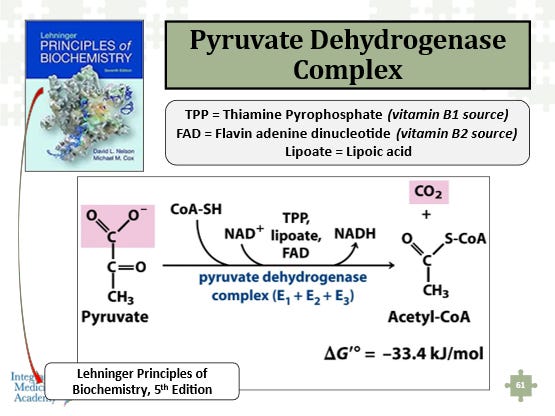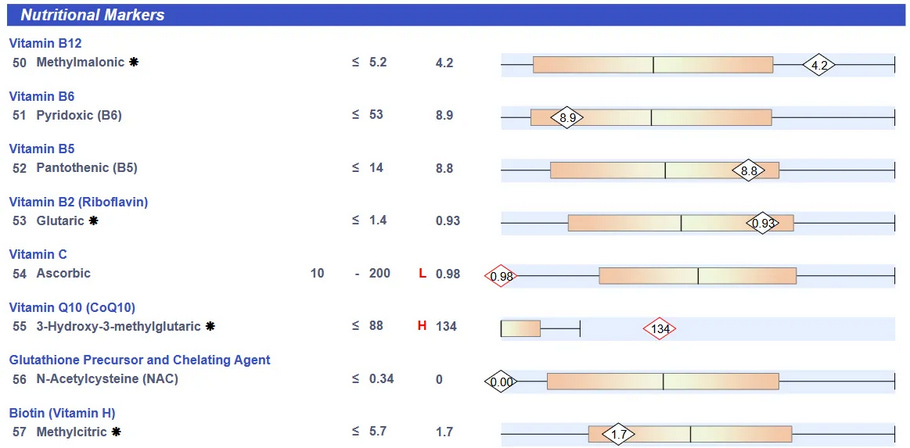Organic Acids Test from a Young Non-Verbal Child with Developmental Delay (Part 3)
Mitochondrial dysfunction and laboratory findings from a MitoSwab Test
This article is part 3 of the analysis of an organic acids test (OAT), from Mosaic Diagnostics Laboratory, which comes from a young child with a special needs diagnosis. This individual struggles with poor eye contact, sensory system imbalance, developmental delay (poor milestone development), and constipation.
To review the entire OAT profile, along with my description of test markers make sure to read article 1 - HERE.
This article also discusses a MitoSwab Test on this individual. The MitoSwab Test is a buccal swab sample that analyzes different components within the mitochondria. HERE is a short video on the MitoSwab Test.
Before discussing the MitoSwab Test results, the next series of images come from the Organic Acids Test (OAT).
Glycolytic Cycle Metabolites
The lactic is high normal, and the pyruvic is elevated. Both are linked to glycolysis and can occur elevated for various reasons. A common scenario is low conversion of pyruvic to acetyl-CoA because of nutrient deficits such as B-vitamins, including B1, B2, B3, and B5.
Image 1 - high normal lactic acid and elevated pyruvic acid suggests some imbalance within the mitochondria or the function of pyruvic acid dehydrogenase, aka pyruvate dehydrogenase (next image).
Image 2 - the pyruvate dehydrogenase enzyme converts pyruvate to acetyl-CoA through the support of various B-vitamins such as B1 and B2. This slide image comes from the Mitochondrial Mastery Course of Integrative Medicine Academy.
Mitochondrial Markers - Krebs Cycle Metabolites
Multiple markers elevated within the Krebs cycle indicates a mitochondrial dysfunction. The high succinic is linked to complex II of the electron transport chain through an enzyme succinic acid dehydrogenase. Fumaric, malic, and citric often appear elevated when there is high fungus, oxalic acid, and subsequent oxidative stress.
Image 3 - any marker elevated in this section of the OAT indicates the likelihood of dysfunction within the Krebs cycle. For example, succinic elevation is commonly associated with environmental toxin exposure and damage at complex II of the electron transport chain.
Mitochondrial Markers - Amino Acid Metabolites
Markers #30 and #32 are linked to amino acid leucine, and #31 to Lysine. In this case, all values are normal.
Image 4 - these compounds are linked to L-leucine and L-lysine amino acid metabolism.
Ketone and Fatty Acid Oxidation
This section of the OAT is also linked to mitochondrial function, and can occur elevated when there are mitochondrial fatty acid metabolism problems or a deficiency in L-carnitine.
Image 5 - the Ketone and Fatty Acid Oxidation section of the OAT is important with regards to understanding fatty acid metabolism imbalances.
All markers, except adipic, are elevated. There are many factors that can lead to elevated ketone and fatty acid oxidation markers. In many situations, this pattern is seen with mitochondrial problems, oxidative stress, and low L-carnitine. The high 3-hydroxybutyric and acetoacetic (both ketones) could be occurring from poor redox chemistry within the mitochondria. In some circumstances, the elevated ketones can be induced from a ketogenic or specific carbohydrate diets.
MitoSwab Test
Image 6 - this section of the MitoSwab Test shows the activity of citrate synthase, complex I (RC-I) and complex IV (RC-IV).
The elevated citrate synthase activity measured in the buccal sample suggests a compensatory or corrective response to an underlying mitochondrial dysfunction. This dysfunction could be occurring at some other step within the Krebs cycle or electron transport chain.
Image 7 - the second part of the MitoSwab Test evaluates for complex II and the combination of complex II and III activity. To obtain these two additional markers the test has to be ordered as the MitoSwab Plus.
RC-II activity is normal, but the combination of RC-II & RC-III is below normal. This is significant as complex III is the final protein complex within the mitochondria for the transfer of electrons to complex IV. If the flow of electrons is compromised because of low activity there is increased potential for oxidative radical formation within the mitochondrial and lower overall production of adenosine triphosphate (ATP).
A few additional contributing factors in this case is the lack of CoQ10 and glutathione. The next two images from the OAT show a CoQ10 deficiency and lack of glutathione.
Image 8 - this is the Nutritional Markers section of the OAT. Markers with an asterisk are indirect meaning their elevation indicates a deficiency of the corresponding compound.
There are multiple markers within the Nutritional Markers section of the OAT. In this case, marker #50 is high normal (indicating an increase need for B12), B6 is low normal, glutaric is high normal (indicating some need for B2), and vitamin C is low. The highly significant marker #56 indicates a CoQ10 deficiency which would compromise mitochondrial function.
Image 9 - pyroglutamic and 2-hydroxybutyric are elevated indicating a glutathione deficiency. A lack of glutathione can compromised mitochondrial function.
Image 10 - with regards to glutathione status markers #58 and #59 are important. Elevations indicate a glutathione deficiency or an increased demand for glutathione production, respectively.
The main focus in this section are the elevated pyroglutamic and 2-hydroxybutyric acids indicating a glutathione deficiency. Elevated orotic and 2-hydroxyhippuric are seen with difficulty in processing ammonia, and digestive bacterial imbalance.
The final OAT section looks at inborn-errors of metabolism. There are a few markers elevated in this child. The marker most significant for this case is 3-methyl-2-oxovaleric.
Image 10 - these amino acid metabolites can be associated with rare inborn-errors of metabolism in children.
Marker #75 may indicate a problem in metabolizing succinic acid which compromises Kreb cycle activity. 3-methyl-2-oxovaleric elevation is seen with a thiamine (B1) deficiency. B1, along with many other B-vitamins such as B2, B3, and B5, are linked to mitochondrial activity. Therefore, in this case there are multiple markers on the OAT indicating a need for additional B-vitamins.
In this case, the decision was made to first initiate antimicrobial supplement intervention discussed in article 2. This was followed with foundational nutrient support for mitochondrial and general B-vitamin, and antioxidant support. The following group of supplements come from New Beginnings Nutritionals:
Spectrum Needs - https://www.nbnus.net/products/784-spectrumneeds-powder-new/?bc=no - one scoop twice daily.
Omega Needs (softgel) - https://www.nbnus.net/products/756-omeganeeds-60-softgels-new/ - two softgels daily.
L-Carnitine - https://www.nbnus.net/products/537-l-carnitine-tartrate-60-capsules/?bc=no – one capsule daily.
Ubiquinol - https://www.nbnus.net/products/414-ubiquinol-60-softgels/ - one softgel daily.
Benfotiamine - https://www.nbnus.net/products/523-benfotiamine-vitamin-b1-60-caps/ - one capsule daily.
C-RLA (liquid) - https://www.nbnus.net/products/632-c-rla-liposomal-vitamin-c-and-r-lipoic-acid-10-fl-oz/ - ½ teaspoon daily away from food.
Disclaimer - this information is for educational purposes only. The amount of each product are specific for this case only and may not be appropriate or necessary in other situations.
Follow-up consultations and monitoring of changes in laboratory testing is important overtime. With regards to the Organic Acids Test it is recommended to repeat the test again after 90 days of implementing nutritional intervention. In some cases, doing a Microbial Organic Acids Test (MOAT), which evaluates the markers on page #1 of the OAT, at 60 days is worthwhile if the original OAT shows elevated clostridia bacterial markers.
With regards to the MitoSwab Test the length of time for retesting is recommended at 9 month to one-year.
















